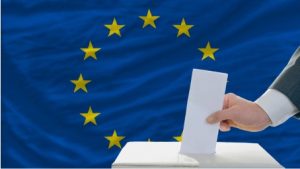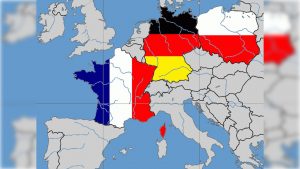This paper, focusing on its perception by the Kremlin, identifies two core contributors to the deterioration of EU–Russian relations: firstly, the clashing integrational attempts in Eastern Europe – namely the conflict between the EU’s Eastern Partnership (EaP) and the Russian Eurasian Economic Union (EEU) – which Moscow interpreted as a western intrusion into its private sphere of influence, the “Russian near abroad”, and secondly the Kremlin’s response to this growing geoeconomic friction in the form of initiating a new campaign of coercive diplomacy that escalated the situation into a geopolitical crisis.
By the end of the Yeltsin era, in 1999 Russian–European relations were nothing alike the rivalry and mutual distrust that describes much of the second half of the twentieth century. Less than a decade after the dissolution of the USSR, Russian lawmakers not only considered the European Union a diplomatic partner, but also a community that Russia is regrettably not a member of. A continuation of this amicable relationship can be observed in the early years of Vladimir Putin’s presidency as the growing economic cooperation, the reliable energy supply and the alliance in the ‘war on terror’ further strengthened the Brussels-Moscow axis. This ‘strategic partnership’, albeit considered an unmatched opportunity to affect world affairs for the better, lasted less than a decade as both parties began expressing their dislike of the hostile behaviour of the other. While Russia saw malicious intent in the EU’s ever-growing integration of Central and then Eastern Europe, lawmakers in Brussels started to give voice to their concerns regarding Russia’s return to its autocratic roots both in its domestic affairs and, more importantly, in relation to the post-soviet space. This gradual worsening of EU-Russian relations culminated in the Ukraine crisis and more specifically in the Russian annexation of Crimea.
First part: Troubles in the shared neighbourhood
The EU’s 2004 and 2007 enlargements have created a shared neighbourhood of the block with the Russian Federation. Motivated by the success of “spurring and shaping Central Europe’s transformation” (Cadier, 2014), the European Union wanted to further capitalize on the integration of post-communist countries, now in the post-soviet space. However, the growing ‘enlargement fatigue’ of the mid-2000s blocked any initiative suggesting the accession of further states to the block. To solve this dilemma, the EU created the European Neighbourhood Policy (ENP), which essentially allowed Brussel to assert influence over non-member states, by offering financial aid, visa facilitation and privileged access to the internal market in return for political, economic and administrative reforms. For the regionalization and instrumentalization of the ENP in the former Soviet space, in 2009 the EU created the Eastern Partnership (EaP) involving Armenia, Azerbaijan, Belarus, Georgia, Moldova and Ukraine.
Although the EaP incorporates some political ambitions, such as the promotion of democracy and the rule of law, Sasse argues that the program has clear limitations on this field. The two core constraints of the EaP’s political objectives are its relatively small budget of €600 million, and its reliance on the cooperation of domestic actors such as governments and elites. These factors render the Eastern Partnership a negligible geopolitical factor and restrict it to its economic reality. A particular piece of evidence that verifies this hypothesis is the worsening freedom house indicators of all but one EaP countries between 2006 and 2011. When assessing the EaP’s economic effectiveness it is important not to oversimplify and prematurely conclude that it does not exide fundamental trading deals. Integrational frameworks, in general, have a long-term transformative potential commonly referred to as ‘structural power’, which is best defined as: “power to shape and determine the structures of the [regional] political economy within which other states, their political institutions and their economic enterprises [operate]”. Hence, as the EU is making conditional offers to former soviet states, in effect it is practising a form of structural power that entirely relies on the willingness of the domestic governments and elites to ‘obey’. This consequently means that the EaP is not an ideal tool for rapid, top-down change or coercion, but it holds the potential for significant reforms if deployed in a cooperative environment.
There is a twofold explanation to why Moscow interpreted the EaP as a significant threat: first, a set of preconditions imply the weakening of the Russian Federation suggesting a state of alerted cautiousness in the Kremlin and second, the EaP’s real or perceived harmful potentials to Russian interests in the region, ranging from general economic cooperation to social and in certain cases military concerns.
In the aftermath of the dissolution of the USSR, all of its former members had to (re-)define their relations with Russia. While Georgia and most prominently the three Baltic states firmly distanced themselves from the ‘mother bear’, the remaining countries created a rudimentary integration block, the Commonwealth of Independent States (CIS). Although it was intended to be a Moscow lead, loose integration framework the CIS eventually turned into a mechanism distancing post-soviet states from Russia. While Moscow was occupied with its own transformation and had difficulties managing its neighbours, the EU and its western allies only strengthened. A clear sign of this powershift was the 1999 NATO intervention in Kosovo that commenced despite its strong Russian opposition. Moreover, in the same year, three former Warsaw Pact countries joined the western military block, only to be followed by Bulgaria, Estonia, Latvia, Lithuania, Romania, Slovakia and Slovenia five years later. These conditions reveal that Russia was in ‘retreat’ both in its close proximity and in the wider international theatre of politics by the mid-2000s. However, the most important precondition of the fierce Russian opposition of the EaP is the 2004 Orange Revolution which Moscow interpreted as a “western coup threatening Russia’s interest in the region”.
Regarding its implications on Russian economic interests, the EaP is not an explicitly anti-Russian initiative. However, a well-integrated Eastern Europe, structurally reorganized by the EU could cause a recession in Russian trade by introducing lower tariffs on European products or alternatively, cause further economic setbacks for Moscow by joining future EU lead sanctions.
Although regularly overlooked, the EaP is also, implicitly harmful to Moscow’s social interest
in Eastern Europe, which concerns the minority rights of ethnic Russians in former Soviet
states. While it might seem out of ordinary to portray Putin as a defender of human rights against EU sponsored oppression, it is important to emphasise that the discriminatory attitude towards ethnic Russians in the aftermath of the Orange Revolution and the Euro-Maidan had little to no repercussions on EU-Ukrainian relations. Nevertheless, this argument is disproportionately present in the Russian media, it is worrisome for Moscow that the EU actively values a good economic relationship with Ukraine more than civil rights.
The final, and possibly most important aspect of Moscow’s interest in Eastern Europe is the
matter of Russia’s military defence. While Russia still relies on the soviet doctrine of ‘strategic depth’, meaning that a line of allying, or at least neutral countries acting as a buffer between itself and NATO is of crucial military importance, the western military block consumed the Warsaw Pact countries that traditionally fulfilled this buffer’s role. Furthermore, with the accession of the Baltic states, NATO secured a shared border with Russia. However, this limited borderline is only 1,215 km long, which approximately measures half of the border between Ukraine and Russia. Therefore, Ukraine’s NATO membership is a strategic nightmare for Moscow, which can explain the Kremlin’s paranoiac assumption that the EaP is a stepping stone for NATO, although there is no direct link between the two.
As a response to the EaP’s aforementioned harmful potentials, in 2010 Russia and its closest allies, Belarus and Kazakhstan created the Eurasian Customs Union (ECU) and in 2015 the Eurasian Economic Union (EEU) with the addition of Armenia and Kyrgyzstan. Although, it is debatable whether the ECU was meant to be a competitor to the EaP or its real intention was to mitigate the effects of the 2008 and 2009 economic crisis, the EEU’s purpose is unquestionable. As Vladimir Putin described in the article announcing the EEU; major powers increasingly rely on their pedestals of strong and well-integrated countries, hence, the EEU is both inspired by the (structural) power of the EaP and meant to compete with it in order to reinforce Moscow’s strategic position in the region.
While the political ambitions of the EEU are clear the economic rationale opposes them. Data not only shows that the ECU membership has had a negative effect on the economy of the participating states but also, as Stefan Meister argues that “the EEU makes little economic sense” even for Russia. Nevertheless, domestic appetites for trade-offs of other nature, such as the Lukashenko regime’s reliance on Russian support and Armenia’s demand for security guarantees, create alternative incentives for EEU membership.
It is worth mentioning, that Ukraine is a particularly unique example, as it seems that Russia
could not pursue Kiev to join the EEU or to reject the EaP and had to resort to coercive diplomacy to pressure Ukraine into abandoning the negotiations of even closer integration with the EU.






